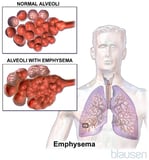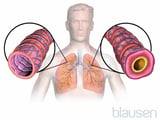Please Dont Run Off Again Im Out of Breath
Shortness of breath—what doctors call dyspnea—is the unpleasant sensation of having difficulty breathing. People experience and depict shortness of breath differently depending on the cause.
The rate and depth of breathing normally increase during exercise and at high altitudes, merely the increase seldom causes discomfort. Breathing rate is also increased at rest in people with many disorders, whether of the lungs or other parts of the body. For example, people with a fever generally breathe faster.
With dyspnea, faster animate is accompanied by the sensation of running out of air. People experience every bit if they cannot breathe fast plenty or deeply enough. They may notice that more effort is needed to expand the chest when breathing in or to expel air when breathing out. They may also have the uncomfortable sensation that inhaling (inspiration) is urgently needed before exhaling (expiration) is completed and have various sensations often described as tightness in the chest.
The most common causes overall include
-
Concrete deconditioning (for example, weakening of muscles and the center due to inactivity)
-
Weight gain
-
Pregnancy
The most common cause in people with a chronic lung or center disorder is
-
Worsening of their disease
However, such people may too develop some other disorder. For case, people with long-standing asthma may have a center attack, or people with chronic heart failure may develop pneumonia.
People who have lung disorders frequently feel dyspnea when they physically exert themselves. During exercise, the body makes more than carbon dioxide and uses more oxygen. The respiratory middle in the brain speeds upwardly animate when blood levels of oxygen are low or blood levels of carbon dioxide are high. If the eye or lungs are not functioning normally, even a little exertion can dramatically increase the breathing charge per unit and dyspnea. Dyspnea is so unpleasant that people avoid exertion. Every bit the lung disorder becomes more than severe, dyspnea may occur even at rest.
Dyspnea may outcome from
-
Restrictive lung disorders
-
Obstructive lung disorders
In obstructive disorders (such as COPD Chronic Obstructive Pulmonary Disease (COPD) Chronic obstructive pulmonary disease is persistent narrowing (blocking, or obstruction) of the airways occurring with emphysema, chronic obstructive bronchitis, or both disorders. Cigarette... read more  or asthma Asthma Asthma is a condition in which the airways narrow—usually reversibly—in response to certain stimuli. Cough, wheezing, and shortness of breath that occur in response to specific triggers are... read more
or asthma Asthma Asthma is a condition in which the airways narrow—usually reversibly—in response to certain stimuli. Cough, wheezing, and shortness of breath that occur in response to specific triggers are... read more  ), resistance to airflow is increased because the airways are narrowed. Because airways widen during inhalation, air can usually exist pulled in. However, because airways narrow during exhalation, air cannot be exhaled from the lungs as fast as normal, and people wheeze and breathing is labored. Dyspnea results when also much air is left in the lungs subsequently exhaling.
), resistance to airflow is increased because the airways are narrowed. Because airways widen during inhalation, air can usually exist pulled in. However, because airways narrow during exhalation, air cannot be exhaled from the lungs as fast as normal, and people wheeze and breathing is labored. Dyspnea results when also much air is left in the lungs subsequently exhaling.
People with asthma take dyspnea when they have an attack. Doctors typically propose people to go on an inhaler on hand to use during an attack. The drug in the inhaler helps open the airways.
Some people with heart failure have orthopnea, paroxysmal nocturnal dyspnea, or both. Orthopnea is shortness of jiff that occurs when people prevarication downwardly and is relieved by sitting up. Paroxysmal nocturnal dyspnea is a sudden, frequently terrifying attack of dyspnea during sleep. People awaken gasping and must sit down or stand to grab their breath. This disorder is an extreme form of orthopnea and a sign of astringent heart failure.
In hyperventilation syndrome, people feel that they cannot get enough air, and they breathe heavily and quickly. This syndrome is commonly acquired by feet rather than a physical problem. Many people who experience it are frightened, may have breast pain, and may believe they are having a heart attack. They may have a change in consciousness, usually described as feeling that events occurring effectually them are far away, and they may feel tingling in their easily and feet and effectually their mouth.
The following information tin can assistance people make up one's mind whether a medico'southward evaluation is needed and assistance them know what to look during the evaluation.
In people with dyspnea, the following symptoms are of particular concern:
-
Shortness of breath at residue
-
A decreased level of consciousness, agitation, or defoliation
-
Breast discomfort or the feeling the heart is pounding or racing or has skipped a crush (palpitations)
-
Weight loss
-
Night sweats
People who have shortness of breath at rest, breast pain, palpitations, a decreased level of consciousness, agitation, or confusion or take difficulty moving air in or out of their lungs should go to the hospital correct away. Such people may need immediate testing, treatment, and sometimes admission to the hospital. Other people should call a doctor. The doctor can determine how rapidly they need to be evaluated based on the nature and severity of their symptoms, their age, and whatsoever underlying medical conditions. Typically, they should exist evaluated within a few days.
Doctors ask questions to make up one's mind
-
When shortness of breath started
-
Whether it started abruptly or gradually
-
How long the person has felt brusk of breath
-
Whether whatever conditions (such equally cold, exertion, exposure to allergens, or lying down) trigger information technology or get in worse
The person is also asked questions about by medical history (including any lung or heart disorders), a history of smoking, whatsoever family unit members who have had loftier blood pressure or high cholesterol levels, and take a chance factors for pulmonary embolism (such as recent hospitalization, surgery, or long-altitude travel).
The physical examination focuses on the centre and lungs. Doctors listen to the lungs for congestion, wheezing, and abnormal sounds called crackles. They heed to the heart for murmurs (suggesting a heart valve disorder). Swelling of both legs suggests heart failure, but swelling of just i leg is more likely to result from a blood clot in the leg. A blood clot in the leg may break off and travel to the claret vessels in the lungs, causing pulmonary embolism.
Treatment of dyspnea is directed at the cause. People with a low blood oxygen level are given supplemental oxygen using plastic nasal prongs or a plastic mask worn over the face. In astringent cases, especially if people cannot breathe deeply or rapidly enough, breathing may be assisted by mechanical ventilation using a animate tube inserted in the windpipe or a tight-fitting face mask.
Morphine may be given intravenously to reduce anxiety and the discomfort of dyspnea in people with various disorders, including a heart attack, pulmonary embolism, and a last disease.
-
Shortness of breath (dyspnea) is unremarkably caused by lung or middle disorders.
-
In people with a chronic lung disorder (such as chronic obstructive pulmonary affliction) or heart disorder (such as heart failure), the near common cause of dyspnea is a burst of the chronic disorder, but these people tin can also develop a new problem (such every bit a heart assault) that contributes to or causes dyspnea.
-
People who accept dyspnea at rest, a decreased level of consciousness, or defoliation should get to the hospital immediately for emergency evaluation.
-
To determine the severity of the problem, doctors mensurate oxygen levels in the blood with a sensor placed on a finger (pulse oximetry).
-
Doctors evaluate people for inadequate commitment of blood and oxygen to the heart (myocardial ischemia) and for pulmonary embolism, merely sometimes symptoms of these disorders are vague.
Source: https://www.msdmanuals.com/home/lung-and-airway-disorders/symptoms-of-lung-disorders/shortness-of-breath
0 Response to "Please Dont Run Off Again Im Out of Breath"
Post a Comment